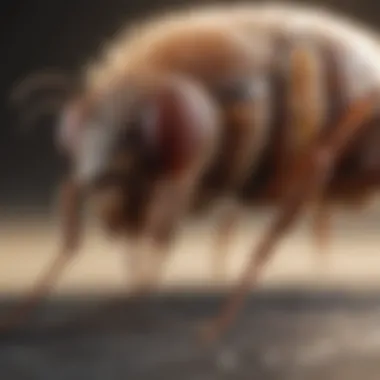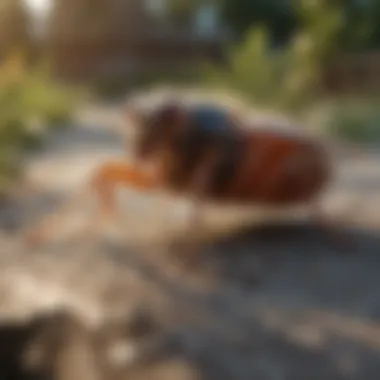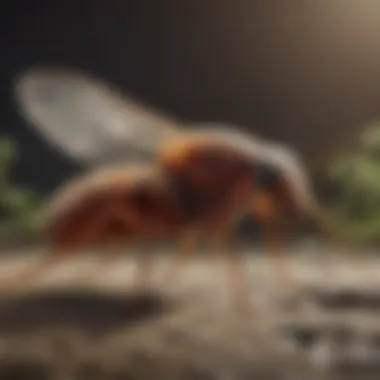Top Strategies for Flea Control in Your Yard


Intro
Fleas are not just an annoyance; they can pose serious risks to the health of pets and humans. Understanding how to manage flea populations in your yard is essential for maintaining a comfortable outdoor environment. This article explores various strategies that can be used effectively to treat your yard for fleas, ensuring a flea-free space for both people and pets. The importance of early detection and knowledge about the flea's lifecycle will guide readers in choosing appropriate control methods and preventive measures.
Understanding the Pest
Identification
Identifying fleas is crucial in addressing an infestation. Fleas are small, wingless insects, typically measuring between 1.5 to 3.3 mm in length. They are brown and have a flattened body, enabling them to move easily through the fur of pets or the fibers of carpets. Common species found in the United States include the cat flea (Ctenocephalides felis) and the dog flea (Ctenocephalides canis).
You may spot them on pets or even notice small dark specks of flea feces in their fur. Adult fleas are fast movers, often jumping several inches away when disturbed. A visual inspection of pets, as well as areas where they frequently rest, can help in identifying the presence of fleas.
Life Cycle
Flea's life cycle consists of four stages: egg, larva, pupa, and adult. Understanding these stages is key in controlling an infestation.
- Eggs: Adult female fleas lay dozens of eggs daily. These are typically found in pet bedding or on carpets.
- Larvae: Flea larvae emerge from eggs and feed on organic debris in the environment, including adult flea feces.
- Pupae: After several days of feeding, larvae spin cocoons and enter the pupae stage, where they can remain dormant.
- Adults: This stage occurs when conditions are right, and they emerge to feed on blood.
The entire cycle can take as little as two weeks or extend to several months, depending on environmental conditions. Early intervention can disrupt this cycle before the flea population expands.
Pest Prevention Strategies
Environment Modification
Modifying the environment is a critical step in flea prevention. Keeping your yard clean and tidy can significantly reduce the chances of flea infestations. This includes:
- Mowing the lawn regularly to discourage flea habitats in tall grass.
- Clearing debris, such as leaves and organic materials, where fleas might thrive.
- Creating shaded areas that deter flea populations from establishing in warm outdoor spaces.
These modifications make your yard less appealing to fleas, especially in spaces frequented by pets.
Physical Barriers
Using physical barriers can also limit flea access to your yard. This involves:
- Fencing to prevent wildlife that may carry fleas from entering your space.
- Maintaining a 3-foot radius around pet sleeping areas to minimize potential infestations both indoor and outdoor.
Simple precautions like these can substantially reduce flea migration into your yard.
Control Methods
Chemical Control
Chemical treatments are often effective but should be approached with caution. Various products are available commercially, designed specifically for yard flea control. These include:
- Insect growth regulators (IGRs): Such as Methoprene and Pyriproxyfen that disrupt flea growth cycles.
- Adulticides: Compounds like Permethrin and Imidacloprid that kill adult fleas on contact.
When using chemical treatments, following the manufacturer's directions is essential. Also, consider applying these treatments during optimal weather conditions to maximize their effectiveness.
Biological Control
For a more natural approach, biological control methods can be implemented. This may include:
- Introducing beneficial nematodes, microscopic worms that prey on flea larvae and pupae.
- Utilizing diatomaceous earth, a natural powder that dehydrates flea exoskeletons upon contact.


Biological controls are less harmful to pets and the environment, making them a suitable option for many homeowners.
Regular monitoring and promptly addressing signs of flea presence can help maintain an effective yard flea management strategy.
Understanding Fleas
Understanding fleas is essential for anyone dealing with pest control, particularly in yards. These pests not only affect our pets but also impact human health. A deeper grasp of fleas helps homeowners develop effective strategies against them. Knowledge about their biology, behavior, and life cycle can significantly enhance control measures. Importantly, this understanding promotes early detection, preventing larger infestations and minimizing the need for extensive treatments.
Biology and Life Cycle of Fleas
Fleas belong to the order Siphonaptera, characterized by their wingless bodies and ability to jump long distances. They have a simple life cycle that involves four stages: egg, larva, pupa, and adult. Adult fleas can lay hundreds of eggs over their lifespan, leading to a rapid increase in numbers. The eggs fall off hosts into grass, soil, and bedding. After a few days, larvae emerge, feeding on organic debris. They then spin cocoons, entering a pupal stage that can last for weeks. Understanding this cycle is crucial when planning yard treatments, as interrupting any stage can help control the population.
Common Species Found in Yards
Several flea species are often found in residential yards, with the most common being the cat flea (Ctenocephalides felis) and the dog flea (Ctenocephalides canis). While both prefer pets as their primary hosts, they can also infest yard areas. Typically, cat fleas are more prevalent due to their adaptability. Understanding the species present in your yard allows for more targeted treatment strategies, ensuring higher efficacy in reducing flea populations.
Health Risks Associated with Fleas
Fleas are more than a nuisance; they pose serious health risks to both pets and humans. Flea bites can lead to skin irritation, allergic reactions, and secondary infections. For pets, excessive scratching can cause hair loss and infections. Moreover, fleas can transmit diseases such as tapeworms and Bartonella, which can affect humans too. Understanding these risks emphasizes the importance of timely prevention and treatment measures, protecting both your family and pets.
Signs of Flea Infestation
Identifying the signs of flea infestation is pivotal in maintaining a healthy yard and home environment. Early detection allows for prompt action, potentially preventing a larger invasion that could affect pets and humans alike. Fleas reproduce rapidly, and without intervention, their populations can explode in a matter of weeks. Recognizing the signs helps homeowners respond effectively and informed.
Recognizing Flea Bites
Flea bites are often the first indication that fleas are present. They appear as small, red, itchy bumps, usually concentrated on the ankles and legs of humans. In pets, signs may include excessive scratching, biting, or licking. Earliness in recognizing these symptoms plays a crucial role in determining the severity of the infestation.
- Visual signs on animals: Look for hair loss or hot spots where pets scratch excessively.
- Skin irritation: Swelling or redness around bite areas may indicate a flea allergy, which can lead to more severe issues if not addressed.
Being aware of these symptoms can help you pinpoint the problem faster and take the necessary actions.
Inspecting Your Yard for Fleas
To effectively treat your yard for fleas, a thorough inspection is essential. Areas that provide shade and moisture are more conducive to flea habitats, typically under bushes, trees, or wooden decks. Here are steps to perform a comprehensive yard inspection:
- Check for flea eggs: Look closely in grassy areas as flea eggs are often laid in these spots.
- Natural flea environment: Also inspect areas where pets frequent, especially in shaded and damp locations. Fleas favor humid conditions.
- Gather evidence: Use a white cloth or paper to pat down the grass and observe for fleas or flea dirt, which is tiny black specks composed of flea excrement.
By methodically inspecting your yard, you can gain a clearer understanding of the scale of the infestation and take appropriate steps.
Using Flea Traps and Monitors
Flea traps serve as an effective tool for monitoring flea levels in your yard. These traps can help confirm the presence of fleas and signify when further treatment is necessary. Here are a few details on how to effectively implement flea traps within your yard:
- Set up traps: Place various flea traps around your yard, especially near pet resting areas. These traps generally work by attracting fleas with light and heat, capturing them in a sticky substance.
- Monitor capture rates: Observe the number of fleas captured over a week, providing insight into the treatment’s effectiveness and helping determine the need for chemical applications or natural solutions.
- Consistency: Regularly using flea traps will help maintain a vigilant watch over your outdoor space.
Implementing these traps not only aids detection but also informs you about the extent of your flea problem, making it easier to decide on further interventions.
Chemical Treatment Options
Chemical treatment options play a significant role in effectively managing flea populations in your yard. These solutions are vital when natural methods do not yield desired results. Using the right chemical treatments can provide quick relief from fleas, allowing homeowners to regain control over their outdoor spaces. However, careful consideration is necessary when selecting and applying these substances. Not all chemical products are created equal, and understanding their specific uses, benefits, and precautions is essential for safe and effective flea management.
Overview of Chemical Pesticides
Chemical pesticides are designed to target pests like fleas efficiently. There are various types of pesticides available, including sprays, granules, and foggers. Each has its specific application method and effectiveness.


Benefits of Chemical Pesticides:
- Rapid action: Many chemical pesticides provide immediate results, killing adult fleas on contact.
- Wide range: They can target various life stages of fleas, including eggs and larvae.
- Ease of use: Most chemical treatments are simple to apply, making them accessible for homeowners.
However, not all chemical pesticides are suitable for every yard. It is essential to consider the following factors:
- Type of vegetation in the yard.
- Presence of pets or small children.
- Environmental impact and safety for non-target species.
Applying Insect Growth Regulators
Insect growth regulators (IGRs) are specialized chemical treatments that disrupt the normal growth patterns of fleas, preventing them from maturing into adulthood. IGRs target the hormonal processes of fleas, which makes them less harmful to humans and the environment compared to traditional pesticides.
Key points about applying IGRs:
- Application Timing: Timing is important. Apply IGRs as part of a broader flea control strategy, typically after an initial treatment with a fast-acting pesticide.
- Persistent Effect: IGRs remain effective for an extended period, providing ongoing protection as new fleas hatch and begin to develop.
- Versatile Use: They can be used both indoors and outdoors, targeting flea eggs and larvae effectively.
Precautions and Safety Measures
While chemical treatments can be effective, safety should always be the priority. Uneven application and misuse can lead to adverse effects. Here are some essential precautions:
- Read the Labels: Always read and follow the manufacturer's instructions carefully.
- Protect Yourself: Wear gloves and masks during application to minimize exposure.
- Keep Pets Indoors: Ensure pets are kept inside during and after treatment until it is safe for them to return.
- Avoid Water Runoff: Do not apply chemicals before heavy rain, as this can wash treatments away and create runoff that may affect nearby water bodies.
"Using chemical treatments should be balanced with environmental considerations and safety protocols to protect all living beings in your environment."
Taking these precautions reduces the likelihood of unintended consequences while allowing for effective flea management. Combining chemical treatments with preventive measures helps keep your yard flea-free in the long term.
Natural and Eco-friendly Solutions
Natural and eco-friendly solutions play a significant role in managing flea populations in yards. The increasing awareness around environmental conservation and the health risks associated with chemical pesticides makes these alternatives particularly valuable. Homeowners are often looking for effective ways to eliminate fleas without introducing harmful substances into their environment. These methods can provide a safer approach for households, especially where children and pets are present. Additionally, they tend to be less expensive over time since many natural solutions can be easily made at home.
A key consideration when opting for natural solutions is their long-term effectiveness and the safe application to the environment. This section will explore specific methods that utilize natural resources, providing options that balance efficacy with safety.
Essential Oils as Flea Repellents
Essential oils are widely recognized for their potential in repelling fleas. Oils such as lavender, peppermint, and eucalyptus contain compounds that are naturally unpleasant to fleas. Using these oils is straightforward; they can be mixed with water and sprayed in areas where infestations are suspected. It's essential to dilute the essential oils appropriately, as undiluted oils can cause skin irritation in both pets and humans.
This method also offers a pleasant scent and remains safe for use around children. However, it is worth mentioning that while essential oils can deter fleas, regular application may be required to maintain their effectiveness.
Diatomaceous Earth as a Natural Pesticide
Diatomaceous earth, composed of fossilized remains of tiny aquatic organisms called diatoms, presents another effective natural solution. When sprinkled in areas where fleas are present, the fine powder can cause dehydration by damaging the soft exoskeleton of insects. Applicability is quite simple; spread diatomaceous earth in infested areas of the yard, ensuring it is kept dry for maximum efficacy.
One consideration to keep in mind is the dustiness of diatomaceous earth. Proper masks and avoidance of breathing in the powder is crucial during application. While it can also control other pests, it remains a safe option for human and pet interaction when applied correctly.
Beneficial Insects in Flea Control
Introducing beneficial insects into your yard is another natural strategy worthy of consideration. Certain natural predators, such as ladybugs and nematodes, can help keep flea populations in check. These insects create a balanced ecosystem in gardens and yards, reducing reliance on chemical methods. Ladybugs feed on aphids, while nematodes are microscopic worms that can attack flea larvae.
To promote the presence of these beneficial insects, providing a diverse range of plants can create a thriving habitat. This approach takes time but contributes to a healthier yard environment. Ultimately, natural solutions can significantly reduce flea encounters, while minimizing environmental impacts.
Preventing Flea Infestations
Preventing flea infestations is key to maintaining a healthy and comfortable yard. Fleas are not just an annoyance; they can lead to serious health issues for pets and humans. Proactive measures can make a significant difference in preventing these pests from taking hold in your outdoor spaces. Preventing fleas involves understanding their lifecycle and the environment they thrive in, and this knowledge can guide homeowners in taking the necessary steps to keep their yards flea-free.
Maintaining Yard Hygiene


Keeping your yard clean is crucial in preventing fleas. Fleas like to breed in shaded, moist areas with plenty of organic matter. By maintaining hygiene, you reduce the likelihood of fleas finding a suitable environment to proliferate.
Consider the following practices:
- Regular Mowing: Keep your grass short. Fleas prefer tall grass where they can easily hide and reproduce.
- Clearing Debris: Remove fallen leaves, sticks, and other debris regularly. These provide hiding spots for fleas and their eggs.
- Pruning Vegetation: Trim bushes and shrubs, which can create a humid microclimate. Sunlight can help keep the area dry and less favorable for fleas.
Establishing a consistent cleaning schedule will minimize potential flea habitats in your yard. This routine is straightforward yet effective in hindering flea development.
Managing Pet Behavior and Treatment
Pets are often the primary carriers of fleas. Managing their behavior and treatment can prevent fleas from entering the yard and home. Here are several strategies:
- Regular Grooming: Brush animals often to remove fleas before they can settle in. Bathing pets with flea shampoo can reduce their flea load.
- Flea Preventative Products: Use effective flea control products like Frontline or Advantage. These help keep fleas away from your pets. Be sure to follow instructions carefully.
- Review Outdoor Activities: Monitor pet outdoor time, especially in areas where fleas may already be present. Sometimes limiting access to specific zones can make a difference.
A combination of these techniques can ensure that your pets do not contribute to a flea infestation.
Seasonal Considerations for Flea Control
Climate and seasons greatly influence flea populations. Understanding these dynamics is essential for effective prevention:
- Warm Seasons: Fleas thrive in warm weather. In spring and summer, check pets frequently and intensify yard cleaning efforts.
- Cooler Months: Fleas can still survive indoors during winter. Regular indoor and outdoor treatments should be consistent all year to combat hidden fleas.
- Changes in Humidity: High humidity can exacerbate flea issues. Monitor weather patterns and adjust your preventive measures accordingly.
Seasonal awareness enables homeowners to adapt their flea control methods based on environmental conditions, ensuring a timely and effective response.
By taking preventative steps, the possibility of a flea infestation diminishes significantly, allowing for a peaceful and healthy outdoor environment.
When to Seek Professional Help
As you tackle the challenge of treating your yard for fleas, there may come a point when the situation escalates beyond your control. This section emphasizes the importance of recognizing when to seek professional help in order to effectively manage a flea infestation.
Identifying Severe Infestations
Determining the severity of a flea infestation is crucial for deciding whether to engage professional pest control services. A few indicators signal that the infestation is severe:
- High Frequency of Flea Bites: If you or your pets experience persistent flea bites despite your treatment efforts, this is a red flag. An influx of bites indicates that the flea population is thriving in your yard.
- Visible Fleas: During inspections, if you regularly notice adult fleas jumping on your pets or around outdoor seating areas, this suggests that the fleas have a significant presence.
- Inconsistent Treatment Outcomes: If chemical or natural treatments yield little to no results, it may indicate a robust population of fleas that requires expert intervention.
Recognizing these signs promptly can prevent further spread of the infestation.
Evaluating Pest Control Services
When you reach the conclusion to seek professional help, consider the following criteria to ensure you choose a reliable pest control service:
- Certifications and Experience: Look for companies that are certified and have been in the business for a substantial length of time. Experienced professionals are more likely to understand the nuances of flea control.
- Methods Used: Ask about the techniques they employ for flea treatment. Ideally, they should offer a combination of chemical and organic strategies to address various stages of flea development
- Customer Reviews: Research feedback from previous customers to gauge their satisfaction. Look for consistency in positive results and customer service.
These elements help you to make an informed decision, thus enhancing the effectiveness of flea control interventions.
Questions to Ask Professionals
When you contact pest control experts, asking the right questions is vital. Here are key inquiries you should consider:
- What Methods Do You Recommend?: Understanding their proposed approach reveals if their techniques align with your preferences for chemical or eco-friendly solutions.
- What Are the Expected Outcomes?: Establish realistic expectations regarding the timeline for results. Knowing what to anticipate can help you manage your household situation more effectively.
- How Do You Ensure Safety?: Inquire about safety precautions regarding pets and children, as well as the environmental impact of their treatments.
Engaging with professionals can often save time and enhance the effectiveness of flea control efforts. It brings expertise and specialized knowledge into a situation that can quickly become overwhelming.
In summary, recognizing a severe flea attack signals a need for expert intervention can save you considerable time and frustration. This is particularly true when taking into account the proper evaluation of pest control services and articulating relevant questions. Armed with this knowledge, homeowners can better navigate the complexities of flea management.
Epilogue
In this article, we highlighted various strategies including the biology of fleas, signs of infestation, and both chemical and natural treatment options. Recognizing the signs of fleas early can prevent severe infestations. Furthermore, effective treatment methods, whether chemical or eco-friendly, offer diverse options to suit different homeowner preferences.
Preventive measures were also discussed, which are essential to maintaining a flea-free yard. Regular yard hygiene, understanding pet behavior, and timing treatments according to seasonal factors can minimize the risk of future flea problems.
It's important to note that while DIY methods are effective, knowing when to seek professional help can make a significant difference in eradicating a severe infestation. Engaging with trained pest control professionals ensures a comprehensive approach to flea management.







